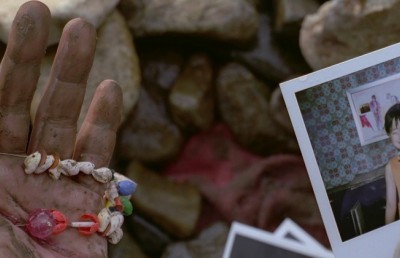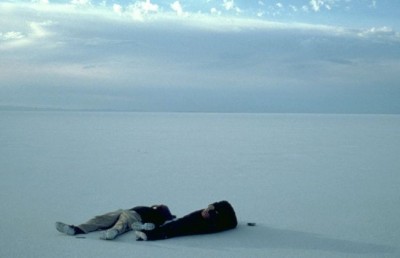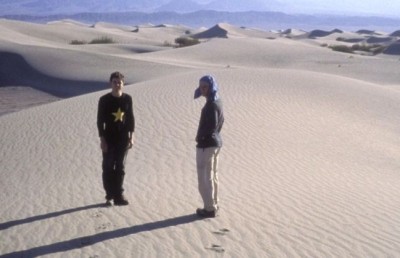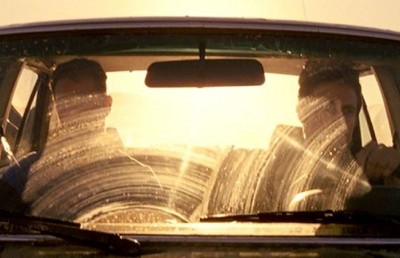The Echopeople: Reflections on the Concept of Echolocation in Gerry: Part 1
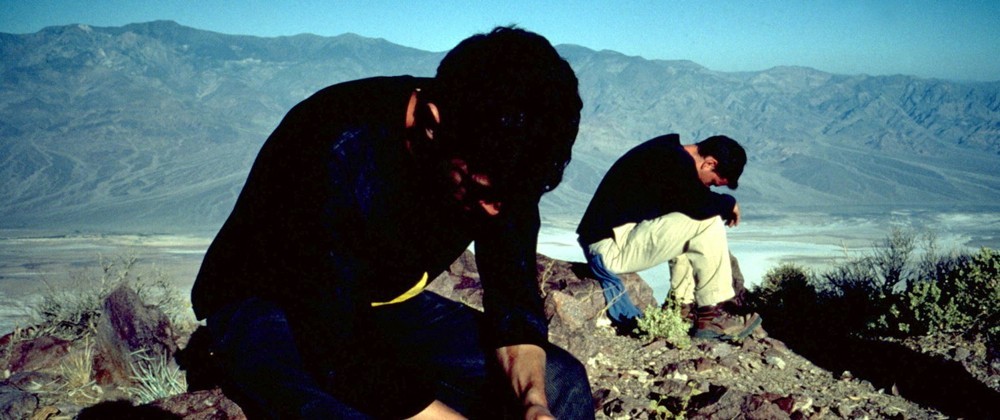
Two truths:
1. Gus Van Sant’s latest film is called Gerry.
2. Gus Van Sant’s latest film is not called Gerries.
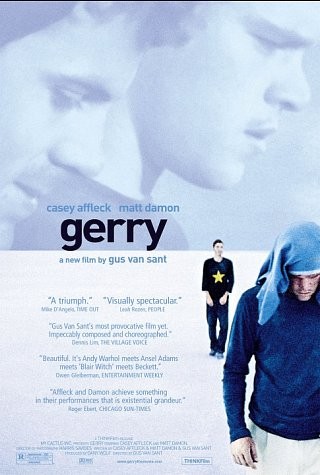
What’s in a name?
Is the title of the film referring to a character’s name, or the word itself? Are both characters in the film actually named Gerry? Or do they just call each other Gerry as part of their mutual language which uses the word to refer to things which have not gone quite right? Gus Van Sant attests to the fact that the word “Gerry” is used as a synonym for a fuck-up, and that the characters in the film refer to each other as Gerry within that context 1 . However, this use of the word is not immediately apparent in the film; the audience is led to believe, at least for a time, that each of these characters is named Gerry. It is not until the various Gerry references pop up, along with a whole host of other specialized terms, that the names of the characters are called into question.
Indeed, there are many phrases in the Gerry dictionary, such as “dirt mattress,” “shirt basket,” “rock marooned,” “high hill crow’s nesting,” and “mountain scoutabout.” Like sailors who have been lost in the desert so long they have forgotten the marine origins of the “crow’s nest” and have applied the term to suit their current surroundings, the film itself is adrift in a sea of reference that makes the familiar seem as strange as the Gerried language permeating the dialogue. This is not to say that the film emulates the characters who seem not to know where they are going. Indeed, a more measured and controlled audiovisual work I have scarcely encountered, and this sure directorial hand makes the film’s references, and the aimlessness of the characters, all the more profound – and asserts the fact that embracing one’s artistic influences need not negate the creation of highly original work.
Like many dualities in the film, there is a tension between the uncontrolled nature of being lost and the controlled manner in which this being lost has been filmed. I’m sure this tension must have rubbed off on the shooting of the film which I imagine likely adapted itself to the environment they found themselves in as they went along. Van Sant suggests that one of the goals of the project was to create something that “we would only outline before we shot it and then do as we were progressing” 2 . This approach is echoed by the character’s use of language in the film. Their terms are thrown around with a nonchalance that suggests they are in firm control of their language, that they have been rock marooned many times, necessitating the frequent use of dirt mattresses. Yet it is also clear that they make a lot of stuff up as they go along, adapting their language and behaviour to meet the needs of their situation. At one point, Affleck’s Gerry warns against the dangers of jumping off his rock, stating that he could break an ankle and force Damon’s Gerry to “barrey” on out of the desert alone in search of aid. This new word is in reference to the moronic "Wheel of Fortune" contestant they discussed earlier: the contestant had but one letter remaining to solve the puzzle “barrel on down the road,” but suggested a Y instead of the L. The desert wanderers thus use the “Gerried” version of the word while keeping its original meaning, rendering the familiar a wee bit strange.
And so it is with the word “Gerry” itself, which becomes a metaphor for all things similar, yet not necessarily the same. Simultaneously a noun, verb and adjective, Gerry can be understood as being many sides of the same thing, just as Damon and Affleck’s characters can be understood as being two sides of the same person. Isn’t this a bit like cinema itself, ever trying to weave together its two main components – sound and image – while so often making us all the more aware of the differences between the two in the midst of their combination? And what happens to any notion of meaning when the contexts of either sound or image are changed in relation to one another, like switching up a single letter in a word or swapping the name of a person with that of another?
Echo
An echo is a reflection. In sonic terms, it is the reflection of one sound off of a surface to create another sound. The reflected sound is similar to the first, but also different. It is the same sound, only given extended life through the act of reflection. Or, it is a second sound, separate from the first, but dependent on it as the source. Echoes recontextualize their sources. Firstly, an echo is the result of a given sound reverberating in a context different from that of its origin. Secondly, an echo will often occur long before the decay of the original sound, thus creating an interaction between the two. Thus recontextualization can be understood not only as a given element stripped of its original environment and dropped into another, but also the interaction between primary and secondary contexts, creating an interplay that is more than the sum of its parts.
The concept of recontextualization is a key element in Gerry which is, like most of Van Sant’s works, a crossover film. Like David Lynch, Van Sant has managed to keep afloat in the world of mainstream Hollywood film while making some films which appeal to decidedly marginal audiences. Like Lynch, Van Sant freely incorporates homage into his works, and creates an environment where recognition goes hand in hand with defamiliarization. In so doing, Gerry crosses over many boundaries. Van Sant cites Andrei Tarkovsky, Alexandre Sokurov, Chantal Ackerman, Rainer Werner Fassbinder, and Béla Tarr (whose films are essentially unavailable to North American audiences) as influencing him a great deal. Indeed, beginning and ending the film with a blue screen is a direct quote from Jarman’s Blue 3 . Tarr’s Satantango is also directly quoted in the film, and I would go so far as to say that Lynch and Michael Snow are also in there (see below). Van Sant thanks Béla Tarr in Gerry’s credits, and states quite clearly that the Hungarian director was a major influence on the work. He speaks particularly about the rhythm of Tarr’s later films, especially Satantango: “For me, there was a point where I would start to notice a lot of things happening even though nothing much was happening. There was a kind of reflection going on in the film and I very much wanted to do something similar” 2 . Van Sant’s use of the word “reflection” is of particular importance here. He is referring to the space that filmmakers like Tarr allow their audiences to think, or reflect, while watching the film. However, the idea of reflecting within the space of the film is quite loaded if we consider the two Gerries in the film as reflections of one another. I suggest an understanding of this reflection as a metaphor for cinema itself in which form reflects content, sound reflects image, and ultimately the audience reflects the filmmakers via the mirror of the screen. This is perhaps the greatest form of crossing over that can occur through a work of art: the minds of author and receiver becoming one through the text 5 .
Yet one of the greatest things about perception is that the perceiver can interpret something entirely different from what was intentionally placed within a work, thus keeping the author and receiver separated. Most often the circle of creation and consumption will involve a combination of points of meeting between author intention and audience reception, a combination that is yet another example of the dance around unity and separation that the cinema embodies through the combination of sound and image – and which Gerry so wonderfully articulates.
Van Sant, though, goes further in his exploration of Bela Tarr’s cinema than just the adoption of a long take aesthetic within austere environments to create a reflective space. As noted, there is at least one shot which is a direct reference to Satantango. The two Gerries walk down a ravine path with a howling wind roaring at their backs hurling dozens of tumbleweeds over their shoulders and on down the road. There is no question that this is an echo of Tarr’s shot of the town saviour and his assistant on their way to reunite with the townspeople, shot similarly from the back as they are pushed along by a wind the blows all manner of trash ahead of them. This shot occurs just before the two Gerries begin their first asserted attempt at recalling the events that led up to their current position. They struggle to remember what they have done, to retrace their steps within the space of their minds, to create a coherent space out of the multitude of environments the desert has engulfed them with to this point. As they try to make sense of their desert travels, their dual perspectives become intertwined and the virtual compass of their memories gets thrown off by the magnetic fields that each exerts over the other. Their memories are echoes of the past mingling with the context of the present, like the shot paying homage to Tarr in the environment of Van Sant’s work.
An echo is a reflection. So it is with the kind of homage Van Sant engages in here, creating a state of crossing over between realms of experience facilitated by intertextual referencing – crossing the boundaries between individual works and creating a blend, mixture, or better yet, a composition.
Location
Indeed, crossing boundaries is the very subject of the film itself. When opening a business, they say that the three most important factors are location, location, and location. Indeed, the business of Gerry is location, which can be broken down into three main categories: location of the shoot, location of the camera on the shoot, and the location of the people and objects within the frame of the shot. The crossing between these three elements of location provides the formal framework in which the basic subject of the film – the location of our heroes in relation to their car, the highway, and each other – can play itself out.
The camera is set up to constantly place the two Gerries in positions where they are crossing each other’s paths, one pushing the other out of view and vice versa in an ongoing choreography of simultaneous separation and unification. The first instance of this choreography sets up a recurring formal strategy that runs throughout the film. The shot begins just after the two Gerries disembark from their car and pass the sign that reads “Wilderness Trail.” Starting as a frontal view of the two hikers, the camera moves backwards to keep pace. Damon’s Gerry leads and often obfuscates Affleck’s Gerry from view since the latter is directly behind him. The shot then cuts to the side view as Affleck’s Gerry overtakes his partner. A leftward track begins, keeping the two in frame for some time until Affleck’s Gerry, now the leader, disappears off the left side leaving Damon’s Gerry alone for a moment. At this point the camera moves from its side view to a rear shot, revealing both once again. Now Damon’s Gerry, being the follower, again eclipsing his partner repeatedly, the two continuously crossing over each other’s paths as they walk. Finally, Affleck’s Gerry veers from the path and Damon’s Gerry regains the lead, turning to his partner and uttering the first words of the film: “Hey, Gerry, the path.”
Not only does this shot set up the theme of crossing paths, but also sets up a formal exploration of axis. Over the course of the shot, the axis is reversed by 180 degrees: it begins as a frontal view of the hikers and then moves to a rear view. What is especially interesting here is that, while the camera turns 180 degrees, the choreography of the hikers is set up so that Damon’s Gerry is in the foreground for both the front and rear parts of the shot. This is a formal foreshadowing of the end of the film which finds Damon’s Gerry dominating the partnership completely, such that he is the only one who makes it out of the desert alive. Damon’s dominant presence is not only suggested by his placement in the foreground of this shot, but also by the fact that it is Damon’s Gerry who seems to know the proper path while Affleck’s Gerry strays from it.
This shot might also be understood as setting up a formal theme of echo structure. The 180 degree shift is like the end of the shot echoing the beginning, only Damon’s Gerry has been recontextualized from being the leader to being the follower. It could be taken further, perhaps understanding the shot as suggesting the primacy of the original in the face of the copy. Given the fact that Damon’s Gerry wins the game by the end of the film, he could be posited as a metaphor for the source in an echo, while Affleck’s Gerry is the reverberation that follows. In this context, the shot sets up a little dance for dominance. Damon’s’ Gerry leads initially, but, as with any echo, the reflection then takes over. However, Damon’s Gerry reasserts his presence as the source, regaining his position as leader by the end of the shot. Further, within the context of the camera’s point of view, Damon’s Gerry maintains his dominant position even while following his partner. So the formal structure of the shot seems to be suggesting Damon’s status as the dominant Gerry from the beginning, denying the flow that an echo would take if left to its own devices.
It is as if the film wants to thwart the natural processes of generation, decay, and regeneration inherent in the structure of an echo. This thwarting approach is in line with theories in sound recording that are constantly trying to assert the primal position of an original sound in the face of so much degrading electronic reproduction 6 . As we move ever further into an age of technological reproduction, there is a fear of losing ourselves within a sea of our own copies. Our two Gerries here are lost in a vast sea, with only each other to ground themselves. I find it interesting to consider them as being reflections of one another, not knowing where they are, gradually losing a handle on where they came from, and certainly not knowing where they are going. So, they interact in a constant relationship of joining together and pulling away, as an echo might interact with its source in a perfect reverberation chamber where the absence of decay allows a source and its echo to carry on in perpetuity. Such a perpetual motion echochamber is essentially what recording technology allows us to construct. With reproduction machines, an echo can go on for as long as we want it to, making distinctions between the echo and its source impossible, and perhaps even eclipsing the original for all time. So there is a constant struggle, or dance, between sensibilities in “an epoch proud of instant copiers but perturbed by errant copies” 7 .
Perhaps Gerry may even be a call to “reconstruct, not abandon, an ideal of authenticity in our lives” 8 . As Hillel Schwartz suggests: “Whatever we come up with, authenticity can no longer be rooted in singularity, in what the Greeks called the idion, or private person. That would be, in our culture of the copy, idiocy…” 8 . The embracing of plurality is a hallmark of the postmodern, a label which is so often found alongside technologies of reproduction. If nothing else, Gerry is surely an exploration of plurality, of the tensions between individuality and communality. Schwartz suggests that the evils we see in copies today may be “agents provocateurs to a more coherent, less derelict sense of ourselves. They may call us away from the despair of uniqueness toward more companionate lives” 10 . The despair of uniqueness is something I feel profoundly when I watch Van Sant’s camera circle 360 degrees around a seated Casey Affleck, followed by another 360 degree pan of the surrounding landscape – empty of all life – set to Arvo Pärt’s Für Alina which itself is an exploration of singularity in the presence of duality (see below). This despair of uniqueness is re-iterated at the end of the film, when Affleck’s Gerry reaches over to make physical contact with Damon’s Gerry for the first time, but is initially rejected. So, when the two Gerries finally do touch each other, we are left with questions: is this contact, ending with the death of Affleck’s Gerry, the conquering of one individual by another, so that the King may once again reign at the expense of either democracy or communism (whichever is more to the reader’s taste)? Or is it the triumph of two finally becoming one so that pretensions towards individuality give way to the embracing of companionship? The latter seems less plausible, unless we decide not to treat the film as some sort of documentary representation of reality, and understand Damon’s Gerry leaving the desert alone as a metaphor for the duality of the two Gerries giving way to their communal existence within one body.
As with a Zen koan, I think posing the questions is more enlightening than the answers 11 . The dance of the two Gerries around each other for the duration of the film is an experience which definitely allows us to reflect on the choreography of its form and substance, as Van Sant wanted us to do. I like to think of this choreography as a metaphor for cinema itself which must always cross the worlds of sound and image over one another to greater or lesser degrees of unity (except in the case of truly silent cinema – and perhaps even then). Thus the film is a meditation on cinema itself: a koan the experiencing of which is its sole purpose, rather than the provocation of any set answers to clean up the litter of Gerries left in our heroes’ wake.
Read Part 2 Here.
Notes
- Van Sant, Gus. “Gus Van Sant on Gerry.” Gerry Press Kit. 2003: 4. ↩
- Van Sant, Gus. 2003: 3. ↩
- Van Sant, Gus. 2003: 4. ↩
- Van Sant, Gus. 2003: 3. ↩
- I am drawing on Umberto Eco’s theories of interpretation as put forth in his three wonderful essays found in: Eco, Umberto. Interpretation and Overinterpretation. Stephan Collini, ed. Cambridge: Cambridge University Press, 1992. ↩
- For the best discussion I have yet encountered on the original vs copy debates in film sound theory, see Chapter 3 in: Lastra, James. Sound Reproduction Technology and the American Cinema. New York: Columbia UP, 2000. ↩
- Schwartz, Hillel. The Culture of the Copy: Striking Likenesses, Unreasonable Facsimiles. New York: Zone Books, 1996: 19. ↩
- Ibid:17. ↩
- Ibid:17. ↩
- Ibid:17. ↩
- Berendt, Joachim-Ernst. The World is Sound: Nada Brahma: Music and the Landscape of Consciousness. Rochester: Destiny Books, 1987: 20. ↩



